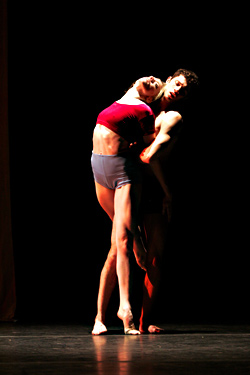After spending the last four years putting his particular stamp on Spectrum Dance Theater, artistic director Donald Byrd has given five local choreographers quite a challenge: for Northwest Best, make a piece with no more than three dancers, no longer than 10 minutes, and in 20 hours of rehearsal time, with Spectrum’s superhoned performers the only link between them all.
Several of the choreographers use their small casts and the studio environment for works about personal relationships rather than abstract pattern making. Cyrus Khambatta opens his duet, Pendulum, with a fairly conventional sequence of bedtime behaviors, such as straightening the covers and hogging the sheets. This theatrical orientation shifts into a more subtle rhythmic connection, with the two dancers phasing back and forth between unison and opposition in a kinetic version of a magician’s sleight of hand.
Daniel Wilkins and Amy O’Neal both made trios with one man and two women that explore the possibilities of three together or two against one. In Ahh . . . umm . . . Damn, Wilkins hints at a sexual relationship among the dancers. O’Nealgenerates a stranger dynamic in difficulties with, creating an odd kind of six-legged, three-headed creature with two of the dancers not so obviously using the third as a kind of puppet. As they pick their way carefully and eccentrically across the stage, the power shifts among them, and the passive role flips from one to another. Neither threesome resolves its relationships. All are still experimenting at the blackout.
In her work with 33 Fainting Spells, Gaelen Hanson usually makes dances that are mysterious and eccentric, laced with theatrical and cultural references. Webern Trio may grow up to be one of those works, but right now it feels like a page in a sketchbook. There’s a hint of romantic attitude in the three women’s balleticized gestures, overlaid with a coy awareness, but whether this knowledge is directed at themselves or some other focus is unclear. The dance is a small part of a bigger picture we can’t see yet.
Despite its title, KT Niehoff’s Study #1 With David and Peter was the most complete among the guests’ works. From the moment David (David Alewine) and Peter (Peter DeGrasse) bang on the studio door and lurch into the space, we see a specific relationship, clearly detailed and thoughtfully developed. Niehoff uses a theatricalized variation of contact improvisation, shifting its conventional interdependence into a more brusque push and pull. She has them underline the pragmatic frustration and accommodation of a close-quarters duet with muttered comments and directions (“Are you gonna go? I got it now”), continually thwarting and cooperating with each other until they finally leave through the door they came in.
Byrd didn’t hold himself to the 10- minute rule, but he’s the boss and can sign his own permission slip. Love’s Delirium, four duets set to a collection of orchestral music by Mozart, contains big servings of complicated dancing. In a post-performance Q&A session, Byrd said he was trying to make something slow, to unpack his usual dense style and find a tender side in his choreography. Although the material is a bit more calm than his typical powerhouse movement choices, it is still full of energy and detail. Even the stillnesses are full of intensity and agitation, so that at the end of a program full of variety, it seems the dancers must either levitate or explode.








